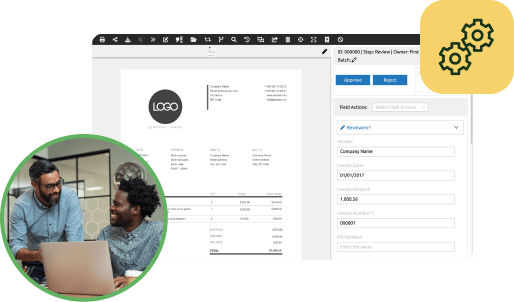
PairSoft
The strongest AP automation, document management, procurement, and fundraising automation platform for mid-market and enterprise companies with integrations to your ERP system.
View all posts by PairSoftPairSoft

Let’s take a look at how we got here. We’ll revisit where accounts payable started, explore its first technological revolution, and seek to understand where it’s going.
During the infantile iterations in the 1980s and prior, accounts payable was a manual process for managing invoices and purchase orders (POs). There were no emails, automated vendor invoices, or digital spreadsheets — all operations were reliant on pen and paper.
This meant receiving invoices by mail; physically storing all documents, invoices, and receipts; hand-delivering paperwork among departments; and manually cutting and mailing checks. Systems of this kind clearly led to countless inefficiencies and errors.
What’s more, it was standard practice for vendors to wait months before their invoices were paid.
This approach was also incredibly resource-heavy, requiring mountains of paper and large file storage cabinets to be competitively effective. Because everything was paper-based, processes were clunky and siloed. It was difficult for other departments to understand what was happening in the accounts payable department and how it affected the company as a whole.
There HAD to be a better way.
Then, in the 1990s, a newly accessible technology triggered the first wave of accounts payable automation — the desktop computer.
In the ‘90s, AP departments utilized computers to conduct their work for the very first time. With this new technology, AP professionals could work more quickly, efficiently, and accurately. They could now receive invoices and correspond electronically, thus speeding up payment processes.
However, even though computers ignited widespread change in AP processes, many functions remained on paper. Payments were still made via physical checks, and manual data entry was still required. Even with tech-enabled advances, severe limitations existed with these old-school approaches to AP operations.
Manual data entry — whether based on paper or computer spreadsheets — is highly error-prone. One misread digit or typo can throw the entire general ledger out of whack, causing time-consuming and tedious investigations to correct mismatched records.
With paper-based processes, the only way to scale up operations was to onboard more employees. This required more money, training, and overhead which contributed to a “two steps forward/two steps back” momentum. There were firm ceilings of what and how much could be done which proved to undercut the progress that computers had initiated.
With paper-based processes, documents are easy to lose or simply forget about. Missing a payment due to a misplaced invoice can damage vendor relationships, as your company will no longer be seen as a reliable client. File mismanagement doesn’t just apply to paper-based processes, either. Accounts payable systems that rely on email and Excel spreadsheets are also vulnerable to mismanagement.
Paper and paper-related costs are expensive. These charges include equipment and maintenance for printers, supplies, postage, file cabinets, and even rent. Expansive document filing systems require some companies to rent larger offices than are necessary because they need space to store their paperwork. Paper also carries significant non-monetary costs with its environmental harm.
New technology opened the door to new types of problems. Computers made new types of AP fraud possible, and in the early days, security and fraud prevention measures were limited.
Though computers brought about huge change and major advancements for the AP function, better solutions were still needed. This brings us from accounts payable processes of the recent past to AP of today and the future.
Today, accounts payable is largely based in the cloud, handled by third-party software-as-a-service (SaaS) providers. While modern businesses use these tools to cut down on paper waste and make it easy to process and pay invoices electronically, they may still be missing out.
That’s because many are not streamlining AP functions as much as they could be with sophisticated AP automation. In fact, without smart AP automation, many AP teams are behind the times and wasting unnecessary resources. Thankfully, AP automation solves the historical problems of yesterday’s approaches to accounts payable.
AP automation leverages software to create fast and efficient workflows that streamline the invoice payment process. It eliminates the need for manual tasks, like invoice processing and approving invoices, PO matching, cutting checks, and stitching together data from your bank statements, ERP spreadsheets, and other tools.
An automated AP workflow might resemble the following multi-step process:
Not only does AP automation allow accounts payable teams to work more efficiently, it also improves several key areas of the accounting and operations processes. The following are a few benefits of AP automation:
It can be difficult to choose the right AP automation software for your business because there are many different factors that need to be accounted for. Teams should follow the following high-level process when selecting the best AP automation software for their unique situation:
When vetting vendors to select the right AP automation software, these are some key features you’ll want to look for:
PairSoft checks all of the boxes you need your AP automation software to fulfill. Our streamlined AP automation system is the modern solution for AP teams both of today and the future. And it seamlessly integrates with the ERP you already use and many you might choose to migrate to in the future, like Microsoft Dynamics, Blackbaud, NetSuite, and Sage Intacct.
With PairSoft, AP teams enjoy bottleneck-free approvals, consistent process controls, visibility into invoices processing across companies and locations, secure document retention with fast retrieval, and more. All of these benefits boil down to two key wins: making your job easier and saving your company money.
Get in touch with our team to schedule a free demo to find out how PairSoft can transform your accounts payable process today.
Get a free demo to learn how our tailored workflows have boosted the AP performance for organizations of all sizes.


Many organizations start with manual receipt handling, fragmented card feeds and slow AP processes. Implement AI agents to auto-capture receipts, route approvals, enable punch-out buys and post to the ERP.
Result: faster batching, fewer errors and cost savings. “This saves us hours every month.”
Many organizations face slow, paper-heavy AP and fragmented procurement that waste time and inflate costs. AI Agents can automate approvals, PO matching and record sync to improve speed, accuracy and control. Client quote: “It freed up hours and made our process reliable.”
Operational drag and rising costs slow growth: teams waste time on manual tasks, misaligned priorities and opaque processes. AI Agents help automate routine work and coordinate actions across teams. “We’ve lost time to repeats and handoffs,” says a typical client.
Companies struggle with manual procurement, fragmented approvals, and costly integrations that slow growth and obscure spend. Our AI Agents streamline requisitions, POs, and invoice matching to cut manual work and improve visibility. “We were wasting time and missing insights,” says a client.

Many teams start with fragmented PO/AP systems, manual matching and delayed financial reporting. Deploying AI agents to automate PO checks, real-time encumbrance tracking and invoice matching reduces processing time and errors, delivering live budgets and faster closes. “Finally, we can see current balances and approve instantly.”
Many companies juggle growing invoice volumes and legacy systems. They struggle with manual processes, compliance gaps and limited headcount. Our AI Agents automate integrations, enforce rules and surface exceptions. The typical outcome: faster closes and measurable ROI. “We stopped chasing invoices.”